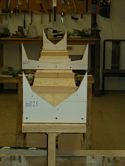 |
A couple hours later,
the accurate strongback mold is ready to receive the hull plates. To get
to this stage will take about one afternoon. The cumulative time saved
thanks to this setup will be measured in days over the length of the project.
A precise strongback assures:
- Perfect symmetry
and shape of the kayak regardless of your skill level.
- No "second
guessing" of your work.
- Rock solid platform
to work on
- Frees both hands
to wire, align, fillet, sand, scrape, glass, epoxy coat, squeegee, cut
and everything else you need to use both hands for.
- No temporary fastening
solutions to waste time on and to get in the way of the work.
|

